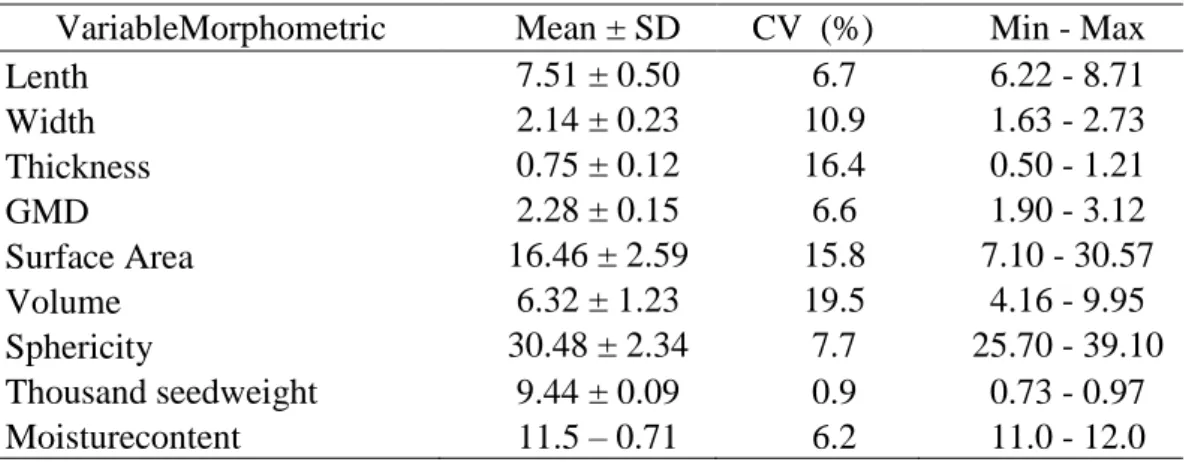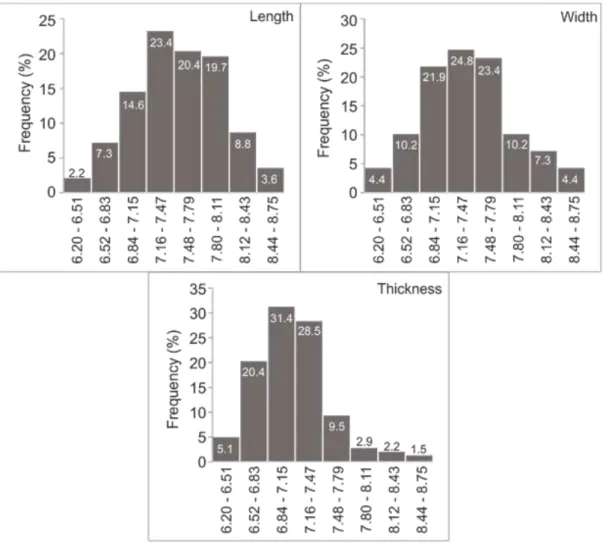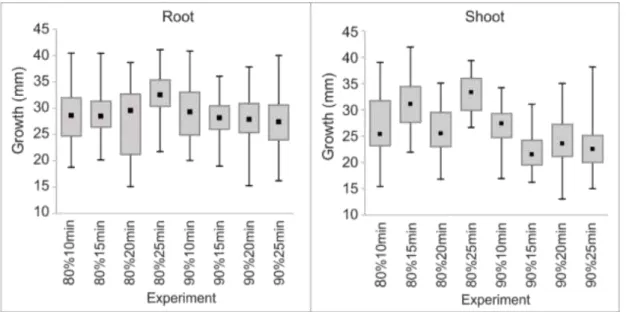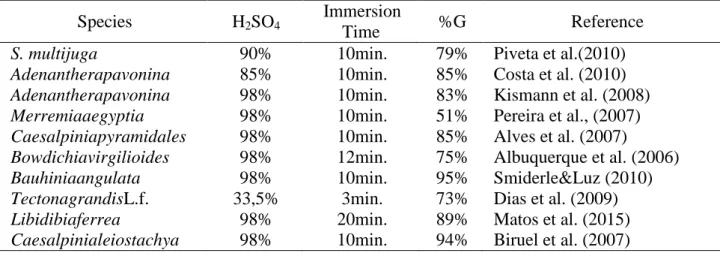1098
Revista da Universidade Vale do Rio Verde, Três Corações, v. 14, n. 1, p. 1098-1106, jan./jul. 2016
MORPHOMETRIC CHARACTERIZATION AND OVERCOMING OF
DORMANCY BY CHEMICAL AGENT IN SEEDS OF Senna multijuga (Rich.)
Edevaldo da SILVA1* Maria de Fátima de Souza GUILHERME2 Pedro Silva dos SANTOS3
1Biólogo, Doutor em Química. Universidade Federal de Campina Grande. edevaldos@yahoo.com.br
*Autor correspondente.
2Graduanda em Ciências Biológicas. Universidade Federal de Campina Grande. fatima.souza.guilherme@gmail.com 3
Graduando em Ciências Biológicas, Universidade Federal de Campina Grande. pedrosantosjs88@gmail.com
Recebido em: 09/04/2016 - Aprovado em: 27/05/2016 - Disponibilizado em: 30/07/2016
ABSTRACT: Senna multijuga (Rich) is a species of the Leguminosae family. Its importance resides in its wide used in
reforestation of degraded areas. However, its seeds has a long dormancy period. The objective of this study was to characterize the morphology of the seeds of S. multijuga and evaluate the influence of sulfuric acid as a chemical agent in overcoming its dormancy. The seeds were characterized by nine morphometric measurements. The effectiveness of sulfuric acid in breaking dormancy was evaluated at two concentrations (80% and 90%) and in four times of immersion (10, 15, 20, 25 min.). Response variables observed were germination percentage, germination speed index (GSI), initial seedling growth (root and shoot length). S. multijuga presented small, elongated, little spherical seeds with a low moisture content. Seeds exposed to treatment with 90% sulfuric acid and immersed for 10 minutes showed better results for percentage of germination and GSI without negative effects such as the integrity of the initial growth of seedlings. Thus, sulfuric acid is effective in breaking dormancy S. multijuga and optimization proposal reduces by about 10% in the consumption of acid, keeping a short time by immersion pretreatment and high germination viability.
KEYWORDS: biometrics.scarification chemistry.Fabaceae.sulfuric acid. germination.
CARACTERIZAÇÃO MORFOMÉTRICA E SUPERAÇÃO DE
DORMÊNCIA POR AGENTE QUÍMICO EM SEMENTES DE Senna
multijuga (Rich.)
RESUMO: Senna multijuga (Rich.) é uma espécie pertencente à família Leguminosae, com importância florestal,
utilizada em reflorestamento de áreas degradadas. O objetivo deste trabalho foi caracterizar a morfometria das sementes de S. multijuga e avaliar a influência do ácido sulfúrico como agente químico na superação da sua dormência. As sementes foram caracterizadas por meio de 09 medidas morfométricas. A eficácia do ácido sulfúrico na quebra de dormência foi avaliada em duas concentrações (80% e 90%) e em quatro tempos de imersão das sementes (10, 15, 20, 25 min.). As variáveis resposta observadas foram: percentual de germinação, Índice de velocidade de germinação (IVG), crescimento inicial das plântulas (comprimento da raiz e da parte aérea). A S. multijuga apresentou sementes pequenas, alongadas, pouca esférica e com baixo teor de umidade. O tratamento com ácido sulfúrico a 90% por 10 min., apresentou melhores resultados para o percentual de germinação e IVG, sem efeitos negativos na integridade do crescimento das plântulas. Assim, o ácido sulfúrico é eficiente na superação da dormência de S. multijuga e, a otimização proposta reduz, em cerca de 10%, no consumo de ácido, mantendo pouco tempo de pré-tratamento por imersão e alta viabilidade germinativa.
1099
Revista da Universidade Vale do Rio Verde, Três Corações, v. 14, n. 1, p. 1098-1106, jan./jul. 2016
INTRODUCTION
Senna multijuga is a species of the
Leguminosae family, common in the Southeast, South and Northeast regions of Brazil and the Federal District. It is known as pau de cigarra, caqueira, aleluia, canafístula, angico-branco, acácia, amarelinho, chuva-de-ouro, pau-fava and piúna (Amorim et al., 2008).
The high degree of devastation of native forests in Brazil is leading to the extinction of many species, causing an ecological imbalance in the environment (Alveset al., 2007). S. multijuga has an importance to forests, being widely used in revegetation programs in these degraded areas and adapted to different types of soil (Ferreiraet al., 2007).
The development germination of a seed involves many physiological processes (Silva et al., 2014). The knowledge of the main processes involved in the germination of native species seeds is important for the preservation of endangered species and their multiplication in reforestation programs (Smiderle & Luz, 2010).
In these species, the presence of seeds, even of viable ones, that do not germinate under favorable environmental conditions is common. They are considered dormant. They need therefore a special treatment to germinate (Mendonça et al., 2015).
The retardation of germination due to dormancy evolved as a survival mechanism of
species in certain climatic conditions (Alves et al., 2007). It is attributed to hard impermeable integument that restrict water and oxygen, preventing the growth and development of the embryo (Kissmannet al., 2008).
The use of a germination test is important to assess the viability of seeds during storage, to estimate the causes of dormancy and to evaluate methods of overcoming dormancy (Gordin et al., 2012).
The impermeability of the seed coat to water is a very frequent dormancy type in Leguminosae species (Alves et al., 2007), being attributed to an inherited trait (Nascimento et al., 2009). However, scarification processes (Alves et al., 2007) can overcome it.
Chemical scarification with sulfuric acid has been investigated as one of the best alternatives to overcome dormancy (Mendonça et al., 2015; Nascimento et al., 2009; Sousa et al., 2010), being highly efficient to break the impermeability of the seed coat. However, the success is influenced by time of exposure to the substance used and species (Zucareli et al., 2011).
The requirement of specific treatments to break dormancy is essential, because dormancy difficults work in vivaria and increases the cost of seedling production and planning of plantations.
The objective of this study was to characterize the morphometry of the seeds of
1100
Revista da Universidade Vale do Rio Verde, Três Corações, v. 14, n. 1, p. 1098-1106, jan./jul. 2016 S.multijuga and evaluate the influence of
sulfuric acid in overcoming its dormancy.
MATERIALS AND METHODS
Seeds of S. multijuga were acquired at the Institute of Forestry Research and Studies (IPEF - Instituto de Pequisas e Estudos Florestais), Piracicaba, SP.
The thousand seed weight (TSW) and the moisture content were quantified in accordance with Brasil (2009). TSW was determined from counting of eight subsamples of 100 seeds taken randomly. The moisture content was determined in triplicate by the oven method at 105°C for 24 hours.
The length, width and thickness of 140 seeds were determined using a digital caliper (0.01 mm). Length was defined as the region between the basal and the apical portion of the seed. Width and thickness were taken at its middle portion.
The geometric mean diameter (GMD) was determined according to Sahay and Singh (1994), and expressed in millimeters. Surface area (in mm²) and volume (mm³) measurements of seeds were determined according to the equation by McCabe et al. (2005). The sphericity (%) was calculated using the values of GMD and the length of seeds according to the method proposed by Mohsenin (1986).
The chemical scarification with sulfuric acid evaluation (H2SO4) was made through a
4 x 2 factorial design, using two acid concentrations (80% and 90%) in four seed soaking times (10, 15, 20 and 25 minutes). Each treatment was replicated in quadruplicate, with 25 seeds per plot.
For the experiment, the seeds were previously disinfected (2.5% NaClO for 10 min.), followed by washing with distilled water and immersed in 20 mL H2SO4in 80%
or 90% concentrations according to the respective times of soaking evaluated in the experimental design. After soaking, the seeds were rinsed in distilled water and seeded in Petri dishes (150 x 15 mm) containing a sterilized double-leaf germitest paper (105°C for 4 hours), moistened with 7mL of distilled water.
The germinal development of seeds and seedlings were daily evaluated, and lasted for 10 days after germination. The response variables analyzed were percentage of germination and GSI according to Maguire (1962), and growth of seedlings (roots and shoots), measured with the aid of a digital caliper.
Laboratory studies were conducted under controlled conditions, in which dishes with seeds were maintained at a 30ºC ± 2 temperature and a photoperiod of 16 hours with light and 8 hours dark.
Statistical analyses of the results were made using Microsoft Excel 365 and SPSS 20.0 software. The normality of residuals was analyzed using the Kolmogorov-Smirnov test
1101
Revista da Universidade Vale do Rio Verde, Três Corações, v. 14, n. 1, p. 1098-1106, jan./jul. 2016
and the homoscedasticity of variances by Cochran &Barttlet at 5%. Statistical inferences used analysis of variance (ANOVA) followed by Tukey's test to determine statistical significance among variances. The confidence interval at p<0.01 was adopted.
RESULTS AND DISCUSSION
Mean, standard deviation and coefficient of variation values for the various morphometric measurements are shown in Table 1. The TSW of seeds was 9.44 g, with average moisture content of 11.5% and low sphericity (30.48%). The mean values for GMD, surface area and volume were equal to 2.28 mm, 16.46 mm2, 6.32 mm3, respectively.
Table 1. Mean, standard deviation (SD), minimum and maximum values
(Min-Max) and percentage coefficient of variation (CV) of morphometric characteristics of seeds of S. multijuga.
VariableMorphometric Mean ± SD CV (%) Min - Max
Lenth 7.51 ± 0.50 6.7 6.22 - 8.71 Width 2.14 ± 0.23 10.9 1.63 - 2.73 Thickness 0.75 ± 0.12 16.4 0.50 - 1.21 GMD 2.28 ± 0.15 6.6 1.90 - 3.12 Surface Area 16.46 ± 2.59 15.8 7.10 - 30.57 Volume 6.32 ± 1.23 19.5 4.16 - 9.95 Sphericity 30.48 ± 2.34 7.7 25.70 - 39.10 Thousand seedweight 9.44 ± 0.09 0.9 0.73 - 0.97 Moisturecontent 11.5 – 0.71 6.2 11.0 - 12.0
Frequency histograms for length, width and thickness measurements of S. multijuga seeds (Figure 1) showed that most of the seeds had the following ranges (mm): length, 7.16 to 8.11; width, 1.91 to 2.32; thickness, 0.68 to 0.85.
The analisys of overcoming dormancy evaluating the efficacy of different concentrations of sulfuric acid and immersion time of seeds presented results in which immersion times, for the same acid concentration, did not influence the increased germination efficiency (Table 2).
1102
Revista da Universidade Vale do Rio Verde, Três Corações, v. 14, n. 1, p. 1098-1106, jan./jul. 2016
Figure 1. Frequency histograms of biometric measurements (mm): length, width
and thickness of S. multijugaseeds.
Table 2. Effectiveness analysis of sulfuric acid concentrations at various soaking
times for overcoming seed dormancy of S. multijuga.
Concentration (H2SO4)
Immersion Time (minutes) Average general 10 15 20 25 H2SO4 - 80% 40.0aA 24.0aA 29.3aA 37.3aA 32.7A Standard deviation 10.6 6.9 12.9 8.3 10.8 CV (%) 26.5 28.9 43.8 22.3 33.0 H2SO4 - 90% 82.7aB 82.7aB 85.3aB 85.3aB 84.0B Standard deviation 6.1 2.3 4.6 2.3 3.8 CV (%) 7.4 2.8 5.4 2.7 4.5
Equal lowercase letters in the same line indicate statistically similar mean values. Different capital letters in the same column indicate different mean values. Both tests were made with ANOVA followed by Tukey test (p<0.01).
However, there was a significant difference in the percentage of germination
between the two acid concentrations. The 10% increase in the acid concentration (80%
1103
Revista da Universidade Vale do Rio Verde, Três Corações, v. 14, n. 1, p. 1098-1106, jan./jul. 2016
to 90%) increased 2.5 times the percentage of seed germination.
There were also significant GSI differences between the two acid concentrations in which the 90% acid concentration, in all immersion times, showed GSI values two times higher than the experiments with 80% acid (Figure 2).
Root and shoot growth showed no statistically significant variation between the concentrations 80% and 90% (Figure 3). That is, the highest concentration and the exposure of seeds (soaking) for a longer time (up to 25 min) did not compromise the integrity of seeds, which would affect their germinative growth.
Figure 2. Germination speed index (GSI) of S. multijuga
seeds subjected to treatments with H2SO4 to overcome
dormancy.
1104
Revista da Universidade Vale do Rio Verde, Três Corações, v. 14, n. 1, p. 1098-1106, jan./jul. 2016
The values for length, width and thickness were similar to those reported by Amorim et al. (2008). They found similar measures (length: 6.4 mm; width, 2.4 mm; and thickness, 0.8 mm) for S. multijuga. However, TSW and moisture content found in this study were different from those reported by Ferreira et al. (2007) for S. multijuga (18.67 g and 8.60%, respectively).
It was observed that scarification with sulfuric acid 90% for 10 minutes is the option that gives the best efficiency at germination and pre-treatment time of seeds. Under these
experimental conditions (H2SO4 90% for 10
min.), the highest GSI was also obtained, with similar results to those reported by Lopes et al.(2012) with seeds of S. macranthera (GSI = 7.89; 89% germination percentage).
Conditions similar to those considered optimal in this research (H2SO4 90% for 10
min.) were also studied for other dormant seeds of forest species. For some of them, such as S. multijuga, Caesalpinialeiostachya,
Adenantherapavonina, germination
percentages similar to those of this work were found (Table 3).
Table 3. Overview of several studies published in the literature on dormancy breaking of forest
species seeds using sulfuric acid.
Species H2SO4
Immersion
Time %G Reference
S. multijuga 90% 10min. 79% Piveta et al.(2010)
Adenantherapavonina 85% 10min. 85% Costa et al. (2010)
Adenantherapavonina 98% 10min. 83% Kismann et al. (2008)
Merremiaaegyptia 98% 10min. 51% Pereira et al., (2007)
Caesalpiniapyramidales 98% 10min. 85% Alves et al. (2007)
Bowdichiavirgilioides 98% 12min. 75% Albuquerque et al. (2006)
Bauhiniaangulata 98% 10min. 95% Smiderle&Luz (2010)
TectonagrandisL.f. 33,5% 3min. 73% Dias et al. (2009)
Libidibiaferrea 98% 20min. 89% Matos et al. (2015)
Caesalpinialeiostachya 98% 10min. 94% Biruel et al. (2007)
Sulfuric acid causes the weakening and subsequent rupture of the integument, which propitiate water intake, which triggers the process of soaking and germinating of seeds (Albuquerque et al., 2006). Despite being a dangerous method, it is widely used for the treatment of seed dormancy. However, depending on the contact time with the acid, it
can cause deterioration of seeds (Lopes et al., 2012).
CONCLUSION
S. multijuga presents small, elongated,
little spherical seeds with a low moisture content. The immersion of S. multijuga seeds in sulfuric acid at 90% for 10 minutes showed
1105
Revista da Universidade Vale do Rio Verde, Três Corações, v. 14, n. 1, p. 1098-1106, jan./jul. 2016
a great efficiency in overcoming its dormancy, resulting in higher germination percentages and a higher germination speed index, without negative effects to the integrity of seeds for the initial growth of their seedlings.
The optimization proposal reduces by about 10% in the consumption of acid, keeping a short time by immersion pretreatment and high germination viability.
ACKNOWLEDGMENT
The National Council for Scientific and Technological Development – CNPq, for the financial support.
REFERENCES
Albuquerque, K.S., Guimarães, R.M., Almeida, I.F., Clemente, A.C.S. 2007. Métodos de superação de dormência de sementes de Sucupira-preta
(BowdichiavirgilioidesKunth.). Ciência e
Agrotecnologia, 31:1716-1721.
Alves, E.U., Cardoso, E.A., Bruno, R.L.A., Alves, A.U., Alves, A.U., Galindo, E.A., Braga Junior, J.M. 2007. Superação da dormência em sementes de
CaesalpiniapyramidalisTul. Revista Árvore,
31: 405-415.
Amorim, I.L.,Davide, A.C., Ferreira, R.A., Chaves, M.M.F. 2008. Morfologia de frutos, sementes, plântulas e mudas de Senna
multijuga var. lindleyana (Gardner) HS Irwin
&Barneby–LeguminosaeCaesalpinioideae.
Revista Brasileira de Botânica, 31:507-516.
Biruel, R.P., Aguiar, I.B., Pauloa, R.C. 2007. Germinação de sementes de pau-ferro
submetidas a diferentes condições de armazenamento, escarificação química, temperatura e luz. Revista Brasileira de
Sementes, 29:134-141.
Brasil. Regras para análise de sementes.
Ministério da Agricultura, Pecuária e Abastecimento.Brasília: MAPA/ACS, 2009.
395p.<http://www.agricultura.gov.br/arq_edit or/file/2946_regras_analise__sementes.pdf> 09 Set. 2015.
Costa, P.A., Lima, A.L.S., Zanella, F., Freitas, H.2010. Quebra de dormência em sementes de Adenantherapavonina L. Pesquisa
Agropecuária Tropical,40 :83-88.
Dias, J.R.M., Caproni, A.L., Wadt, P.G.S., Silva, L.M, Tavella, L.B, Oliveira, J.P. 2009. Quebra de dormência em diásporos de teca (TectonagrandisL.f.). Acta Amazônica, 39:549-554.
Gordin, C.R.B., Marques, R.F.,Masetto, T.E.,Scalon, S.P.Q. 2012. Germinação, biometria de sementes e morfologia de plântulas de GuizotiaabyssinicaCass. Revista
Brasileira de Sementes,34:619-627.
Ferreira, R.A.,Davide, A.C.,Bearzoti, E., Motta, M.S. 2007. Semeadura direta com espécies arbóreas para recuperação de ecossistemas florestais. RevistaCerne, 13: 271-279.
Firatligil-Durmuş, E.,Šárka, E.,Bubník, Z.,Schejbal, M.,Kadlec, P. 2010. Size properties of legume seeds of different varieties using image analysis. Journal of
food Engineering, 99: 445-451.
Kissmann, C.,Scalon, S.D.P.Q.,ScalonFilho, H., Ribeiro, N. 2008.Tratamentos para quebra de dormência, temperaturas e substratos na germinação de Adenantherapavonina L.
Ciência e agrotecnologia, 32: 668-674.
Lopes, J.C., Barbosa, L.C., Capucho, M.T. 2012. Biometria, dormência e viabilidade de
1106
Revista da Universidade Vale do Rio Verde, Três Corações, v. 14, n. 1, p. 1098-1106, jan./jul. 2016
sementes de Senna macranthera. Revista
Nucleus, 9: 247-256.
Maguire, J. 1962. Speed of germination aid in selection and evoluation for seedling and vigour. Crop Science, 2: 176-177.
Matos, A.C.B, Ataide, G.M., Borges, E.E.L. 2015. Physiological, physical, and morpho-anatomical changes in Libidibiaferrea ((Mart. ex Tul.) L.P. Queiroz) seeds after overcoming dormancy. Journal of Seed Science, 37:26-32. Mccabe, W.L., Smith, J.C.,Harriot, P. 1986.
Unit Operations of Chemical Engineering.
New York: McGraw-Hill Book Company. Mendonça, G.S., Martins, C.C., Martins, D., Lopes, M.T.G. 2015. Aspectos físicos e fisiológicos de sementes de
Fimbristylisdicothoma relacionados à
germinação e dormência.
RevistaCiênciaAgronômica, 46: 539-545.
Mohsenin, N.N. 1986. Physical properties of
plant and animal materials. New York:
Gordon and Breach Science Publisher. Nascimento, I.L., Alves, E.U., Bruno, R.D.L.A., Pereira, E.,Gonçalves, P.N.Q.C., Medeiros, M.S. 2009. Superação da dormência em sementes de faveira
(ParkiaplatycephalaBenth). Revista Árvore, 33: 35-45.
Pereira, E.W.L., Ribeiro, M.C.C., Souza, J.O., Linhares, P.C.F., Nunes, G.H.S. 2007.
Superação de dormência em sementes de jitirana (MerremiaaegyptiaL.). Revista
Caatinga,20: 59-62.
Piveta, G., Menezes, V.O., Pedroso, D.C., Muniz, M.F.B.,Blume, E., Wielewicki, A.P. 2010. Superação de dormência na qualidade de sementes e mudas: influencia na produção de Senna multijuga (L. C. Rich.) Irwin &Barneby. Revista Acta Amazonica, 40: 281-288.
Sahay, K.M.,Singh, K.K. 1994. Unit
operations in agricultural processing. New
Delhi: Vikas Publishing House Pvt Ltd. Silva, E., Oliveira, H.M., Araújo, L.N.C., Guilherme, F.S., Maracajá, P.B.
2014.Caracterização morfológica e qualidade fisiológica de cultivares de sementes de gergelim. Revista Verde de Agroecologia e Desenvolvimento Sustentável, 9: 149-157. Smiderle, O.J., Luz, F.J. 2010. Superação da dormência em sementes de pata-de-vaca (BauhiniaangulataVell).
RevistaAgro@mbiente On-line, 4: 80-85.
Sousa, A.B.O.,Abud, H.F.,Innecco, R. 2010. Superação de dormência de sementes de
Merremiacissoides (LAM.) HALF. F. Revista Caatinga, 23: 1-5.
Zucareli, V., Amaro, A.C.E., Silvério, E.V., Ferreira, G. 2011. Métodos de superação da dormência e temperatura na germinação de sementes de Dioclea violácea. Semina:



